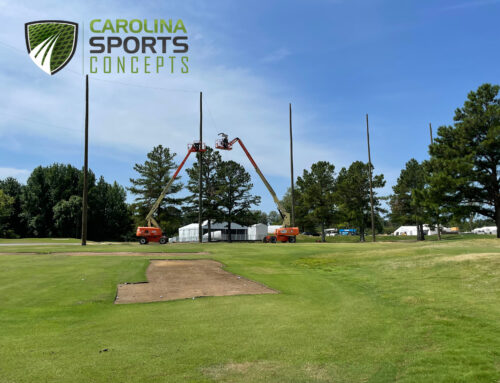As drones continue to advance in what they can do and how well they can do it—anything from aerial photos and videos, to home delivery and surveillance—new safety precautions must also be adopted. One of the evolutionary safety aspects of increased drone usage is incorporating drone netting. Private companies, prisons, drone training centers, are perfect places for the use of large nets. Even if you are just getting started with your drone, Carolina Sports Concepts has all the information you need on netting, regulations, and drone registration.
The fact that drones continue to get more reasonable in price (a drone is a drone is a drone is not true anymore: there is plenty of variety in the levels of drone you can get, all varying in price points), paired with the fact that they are a blast to operate, is driving the popularity of drone usage. Not only that, but we are beginning to see drones being used for beneficial reasons as well: home delivery, photos/videos, etc.
The Need for Mesh
Drone usage is not all fun and games. Because there are plenty of good reasons to use a drone, there are also nefarious reasons to use one. For instance, barring a well-trained carrier pigeon, there has never been a better way to smuggle items into prisons than through drone usage. Even private companies have been reporting the presence of drone surveillance on their grounds—who is operating these drones? Competing companies? Russian spies? It’s hard to say but, regardless, drone usage can easily turn to the dark side and it is important to know how to protect yourself, your company, even society at large from such things.
This is where knitted mesh comes into play. This mesh is made of various metals, minerals, and synthetic materials formed into interlocking loops. There are various kinds of mesh, but they all are incredibly durable.
There are five basic versions of mesh used for catch/repel drones: fine, medium-fine, standard, course, and super-course.
• Fine Mesh. Each line is roughly 0.05mm to 0.15mm thick with 3.5 stitches per centimeter of space. This is the tightest knit you can get and it works exceptionally well against larger, tougher, faster drones.
• Medium-Fine. Here, we get a little looser with a wire diameter of 0.15mm and about 2.4 stitches per centimeter.
• Standard. This is the mesh we see most often, as it has anywhere from 0.2mm to 0.35mm in width, and has 1.6 stitches per centimeter.
• Course. This mesh also comes in 0.2mm to 0.35mm, but the loops are larger, allowing for bigger openings.
• Super-Course. This is the largest (in terms of spaces of openings) of the five with 0.4mm to 0.6mm gaps and 0.5 stitches per centimeter.
Using Netting for Protection
Over the past few years, there has been a rather large uptick in the circumventing of the security systems and infrastructure to prisons through the use of drones. By illegally flying drones above and actually inside of prisons, the incorporation of mesh netting is necessary.
The truth is, we need to act now—this is a new and fast growing problem, not one we have been dealing with for ages. How it can work: the large nets surround the perimeter of the jail yard or the entire prison itself (picture Top Golf).
The nature of mesh usage can be applied to just about any situation where confinement and/or privacy are essential. And if you think about it, this netting can be used just as easily to keep objects within a specified area. Again, look at Top Golf. Without the use of mesh, Top Golf would have a real problem on its hands. Drone training centers are beginning to incorporate standard mesh as well, in order to keep from losing drones.
With continual growth in drone usage—and it doesn’t look like this usage is going to slow anytime soon—it is essential to consider ways of keeping not only the one operating the drone safe but also everyone who encounters that drone along its journey safe as well. Netting or mesh is the perfect method to keep drones without or within.
What to Know Before Flying Your Drone
Before you get a drone for yourself, or as a last-minute holiday gift for someone else, it’s a good idea to run through a few basic “rules of the sky” when it comes to flying your new drone. Here are a few essential piloting tips for beginners:
• Read the Manual. This one seems a bit on the nose but, truthfully, how many of us actually read the manual to anything we buy? With a drone purchase, however, it is a great idea to go ahead and peruse the ol’ book. There are many different types of drones, all varying in speeds, quality, and capability. Before firing up your new flying device, make sure you are clear on everything it can and cannot do.
• Practice with a Simulator. After reading through the manual, consider downloading the DJI GO app for your specific device. This is how you will communicate with your drone, but it is also where you can practice using the controls and actually simulate flights before attempting the real thing. We highly recommend this step, as there have been countless accounts of new drone flyers—who did not take the time to practice—who have lost or crashed their drones on the first flight. Don’t let that happen to you, take the time to learn your new toy.
• Practice in an Open Area. When you are ready to take your drone out for its first flight, make sure the area is as wide open as possible. No matter how confident you are in your flying capabilities, there will be some kinks to work out and it’s best if there are minimal objects present to interfere with your flight.
• Set the RTH. The “Return to Home Mode” is a wonderful feature that tells your drone to safely return to a home point automatically. Using this mode will keep your drone from flying into other objects on its return journey. You can also use this feature to set a particular distance and altitude so you are never in danger of losing your drone. • Know the Drone Regulations. The most basic regulations you need to know are these:
1. Do not fly while under the influence of drugs or alcohol. Drones, if not operated properly, can cause a lot of damage, and if you are flying one while under the influence, you will be held liable for any damage (to people, property, or both).
2. Keep your drone within sight. If you cannot see your drone, you do not have total control of it, no matter how experienced a flyer you are. Keep it in sight and keep it under control.
3. Don’t fly in restricted airspace. Go online and check the Sectional Aeronautical, VFR Terminal Area, or the appropriate En Route charts for your area to gain a clear understanding of where you can and cannot fly your drone.
4. Stay away from other aircrafts. It is not a good idea to fly around other drones, it is even worse of an idea to fly anywhere around airports (airports are considered restricted airspace).
5. Never fly over large groups of people. It may be tempting to fly over a crowd for a cool view, but if your drone were to suddenly lose power and drop, people could become seriously injured. (This brings up another point: always make sure your drone is fully charged!).
6. Stay away from emergency response efforts. Medical emergencies, forest fires, car accidents, are all serious situations and require specially trained people to interact with them. Anything viewed as an interference with those trying to help a situation will be dealt with—and usually not in a fun way. Even if you think you can help by flying a drone over an area that is in distress due to any unforeseen circumstance, let the professionals do what they do best.
Flying a drone can be a lot of fun, especially as new-and-improved features are being added all the time. Do your research, read that manual, and practice your controls and flight patterns. Then go have some fun!







